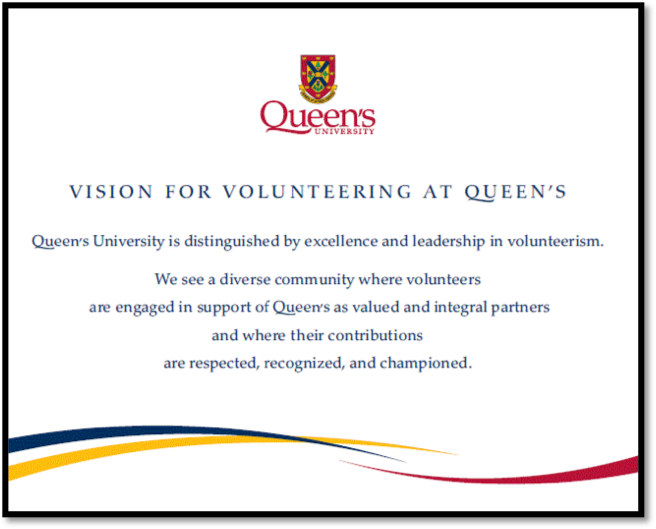
Last week, in the first part of this blog post, we met Maryanne Wainman, Alumni Officer, Volunteer Relations with the Queen’s University Alumni Relations & Annual Giving department. Maryanne explained Queen’s has a long history with volunteer engagement but only recently formalized its processes using the Canadian Code for Volunteer Involvement (CCVI).
After conducting best-practice research, focus groups, and administering surveys, four priority areas for the Alumni Relations & Annual Giving department’s volunteer program were identified. They were: Orientation & Training; Information & Data Management; Evaluation & Feedback; and Risk Management.
To address each of these areas, the department relied heavily on the CCVI to guide their planning and approach. Below are a few highlights of how they used elements of the Code to shape and enhance their volunteer engagement processes:
- Mission-Based Approach: Worked collaboratively with staff and volunteers to create a “Vision for Volunteering at Queen’s” to provide direction for our volunteer relations work, and to raise awareness of the vital importance of volunteer contributions to the life and work of Queen’s. They also updated their volunteer position descriptions to ensure they clearly articulate volunteers’ connection to the organization’s Mission.
- Risk Management & Quality Assurance: Developed an online Volunteer Risk Management Guide tailored to the Queen’s volunteer context.
- Volunteer Roles: Developed a standardized position description template based on skills and competencies
required / acquired , with clearly articulated benefits and connection to the organization’s Mission.
- Orientation & Training: Developed a standardized orientation package with an accompanying checklist for staff members to ensure volunteers are well-equipped with resources and understand how their role fits into the bigger picture.
- Records Management & Technology: Refined existing data-management protocol and ability to track volunteer recognition and interest. Also developed an online Volunteer Opportunities Directory with tools, training materials and enrichment opportunities to enhance both staff and volunteer support.
- Evaluation: Introduced standardized exit interviews for volunteers in key board positions, and a standardized volunteer experience survey for ongoing feedback and year-over-year metrics comparison.
Using the Code to develop their volunteer program has helped the department ensure that volunteers that come forward are screened to ensure the best fit with the best volunteer role. “The CCVI has undoubtedly helped us with this last point, says Maryanne. “The introduction of a standardized position description template with clearly articulated expectations has been instrumental in ensuring volunteers are appropriately matched to roles. Additionally, our renewed focus on ensuring all roles are clearly connected to the organization’s Mission has helped volunteers feel more engaged and valued as integral partners in our work.”
“The CCVI is an invaluable resource, and we highly recommend it, and the accompanying Audit Tool, to anyone who is looking to enhance or further professionalize their volunteer program!” – Maryanne Wainman, Alumni Officer, Volunteer Relations
Queen’s University became official adoptees of the Code in 2013. Since then, the Alumni Relations & Annual Giving department has taken steps to educate their department about the Code and its use, and have incorporated an introduction to the Code in orientation protocol for new staff and volunteers within the department.
To further enhance staff and volunteer support at Queen’s beyond their department’s borders, they developed the content for, and now facilitate the Queen’s Volunteer Engagement Certificate Program (QVEC) for other Queen’s faculty, staff and student groups who work with volunteers. This certificate program provides practical tools and techniques to manage volunteers within the higher-education context, and the CCVI provides the back-bone around which the content is structured.
Thank you, Maryanne, for sharing your experience using the Canadian Code for Volunteer Involvement at Queen’s University and for joining the list of Code Adoptees.
Click here to access the Canadian Code for Volunteer Involvement and other resources.
